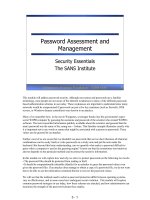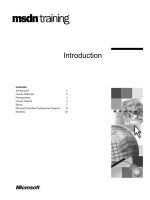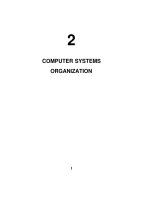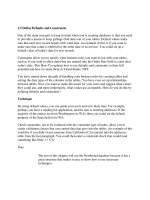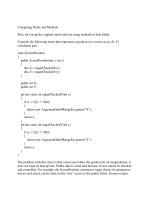Tài liệu FINANCIAL SYSTEMS AND AUDITING ppt
Bạn đang xem bản rút gọn của tài liệu. Xem và tải ngay bản đầy đủ của tài liệu tại đây (657.08 KB, 60 trang )
[Hayes, Dassen, Schilder and Wallage, Principles of Auditing An Introduction to ISAs, edition 2.1] © Pearson Education Limited 2007
Slide 7.1
FINANCIAL SYSTEMS AND AUDITING
Internal Control and Control Risk
MANAGEMENT CONTROL AND
CORPORATE GOVERNANCE
Principles of Auditing: An Introduction to
International Standards on Auditing - Ch. 7
Rick Stephan Hayes,
Roger Dassen, Arnold Schilder,
Philip Wallage
[Hayes, Dassen, Schilder and Wallage, Principles of Auditing An Introduction to ISAs, edition 2.1] © Pearson Education Limited 2007
Slide 7.2
Internal Control is
A process, effected by an entity’s
board of directors, management and
other personnel, designed to provide
reasonable assurance regarding the achievement
of objectives in the following categories:
effectiveness and efficiency of operations,
reliability of financial reporting,
compliance with applicable laws and regulations
and safeguarding of assets against unauthorized
acquisition, use or disposition.
[Hayes, Dassen, Schilder and Wallage, Principles of Auditing An Introduction to ISAs, edition 2.1] © Pearson Education Limited 2007
Slide 7.3
Internal control is geared to the achievement of
objectives in one or more separate overlapping
categories:
1 effective operations — relating to effective and
efficient use of the entity's resources
2 financial reporting — relating to preparation of
reliable published financial statements
3 compliance — relating to the entity's
compliance with applicable laws and
regulations
4 safeguarding of assets
[Hayes, Dassen, Schilder and Wallage, Principles of Auditing An Introduction to ISAs, edition 2.1] © Pearson Education Limited 2007
Slide 7.4
Management Control Objectives
•
Effective Operations goal safeguarding
of assets (cash, accounts receivable,
accounting records)
•
Financial Reporting Need for accurate
information because management has a
responsibility to see that statements are
prepared fairly in accordance with
accounting standards. Auditor is
interested primarily in financial reporting
controls (especially controls over
transactions).
•
Compliance Companies must comply
with many laws and regulations including
company law, tax law and environmental
protection regulations.
[Hayes, Dassen, Schilder and Wallage, Principles of Auditing An Introduction to ISAs, edition 2.1] © Pearson Education Limited 2007
Slide 7.5
Auditor’s Primary Control
Consideration and Emphasis
•
To understand an entity’s internal control, the
auditor will evaluate the design and
implementation of a control.
•
The auditor's primary consideration is whether, and
how, a specific control prevents, or detects and
corrects, material misstatements in classes of
transactions, account balances or disclosures.
•
The heaviest emphasis by auditors is on
controls over classes of transactions rather
than account balances or disclosures.
[Hayes, Dassen, Schilder and Wallage, Principles of Auditing An Introduction to ISAs, edition 2.1] © Pearson Education Limited 2007
Slide 7.6
Design and Implementation of
Controls
•
To understand the entity’s internal
control the auditor will evaluate the
design of a control and judge whether it
has been implemented.
•
He determines if the control is designed
to prevent, detect, or correct
transactions that misstate the account
balances.
•
Implementation of a control means that
the control exists and that the entity is
using it.
[Hayes, Dassen, Schilder and Wallage, Principles of Auditing An Introduction to ISAs, edition 2.1] © Pearson Education Limited 2007
Slide 7.7
Components of Internal Control are
•
Control Environment,
•
Risk Assessment ,
•
Control Activities / Control
Procedures,
•
Information and
Communication and
•
Monitoring.
[Hayes, Dassen, Schilder and Wallage, Principles of Auditing An Introduction to ISAs, edition 2.1] © Pearson Education Limited 2007
Slide 7.8
Components
of Internal
Control
Illustration 7.1
[Hayes, Dassen, Schilder and Wallage, Principles of Auditing An Introduction to ISAs, edition 2.1] © Pearson Education Limited 2007
Slide 7.9
Control Environment
The control environment means the overall
attitude, awareness, and actions of
directors and management regarding the
internal control system and its
importance in the entity.
[Hayes, Dassen, Schilder and Wallage, Principles of Auditing An Introduction to ISAs, edition 2.1] © Pearson Education Limited 2007
Slide 7.10
Elements Contributing to a Successful
Control Environment
(1) Communication and enforcement of
integrity and ethical values;
(2) Commitment to competence;
(3) Participation by those charged with
governance - independence and integrity
of the board of directors;
(4) Management's philosophy and operating
style - leadership via control by example;
(5) Organizational structure;
(6) Assignment of authority and
responsibility; and
(7) Human resource policies and practices.
[Hayes, Dassen, Schilder and Wallage, Principles of Auditing An Introduction to ISAs, edition 2.1] © Pearson Education Limited 2007
Slide 7.11
Risk Assessment
Management assesses risks as part of designing and operating
the internal control system to minimize errors and
irregularities.
Auditors assess risks to decide the evidence needed in the audit.
If management effectively assesses and responds to risks, the
auditor will typically need to accumulate less audit evidence
than when management fails to, because control risk is lower.
[Hayes, Dassen, Schilder and Wallage, Principles of Auditing An Introduction to ISAs, edition 2.1] © Pearson Education Limited 2007
Slide 7.12
Identify Risks
A technique to identify risks involves identifying
and prioritizing high risk activities:
①
identify the essential resources of the business
and determine which are most at risk;
②
identify possible liabilities which may arise;
③
review the risks that have arisen in the past;
④
consider any additional risks imposed by new
objectives or new external factors; and
⑤
seek to anticipate change by considering
problems and opportunities on a continuing basis.
[Hayes, Dassen, Schilder and Wallage, Principles of Auditing An Introduction to ISAs, edition 2.1] © Pearson Education Limited 2007
Slide 7.13
Information and Communication.
Information must be relevant
and delivered to people who
need it in a form and time frame
that allows them to carry out
their control and other responsibilities.
[Hayes, Dassen, Schilder and Wallage, Principles of Auditing An Introduction to ISAs, edition 2.1] © Pearson Education Limited 2007
Slide 7.14
The accounting system;
Customer and vendor records
Production system;
Budget information,
Personnel system;
Computer systems software;
Computer applications software
Sub- systems
[Hayes, Dassen, Schilder and Wallage, Principles of Auditing An Introduction to ISAs, edition 2.1] © Pearson Education Limited 2007
Slide 7.15
accounting transactions
correspondence
personnel information
customer and vendor information
entity objectives and standards
procedure manuals
information about external events, activities
and conditions
Input for Information System
[Hayes, Dassen, Schilder and Wallage, Principles of Auditing An Introduction to ISAs, edition 2.1] © Pearson Education Limited 2007
Slide 7.16
Output of Information System
✱
accounting reports
✱
budget reports
✱
production reports
✱
operating reports
✱
correspondence
✱
all the records and files generated by
applications software
[Hayes, Dassen, Schilder and Wallage, Principles of Auditing An Introduction to ISAs, edition 2.1] © Pearson Education Limited 2007
Slide 7.17
Obtain an understanding of the information
system and the related business processes
relevant to financial reporting in the
following areas:
The classes of transactions in the entity's
operations that are significant to the
financial statements.
The procedures by which those transactions are
initiated, recorded, processed and reported from
their occurrence to their inclusion in the financial
statements.
The related accounting records, supporting
information, and specific accounts in the
financial statements .
[Hayes, Dassen, Schilder and Wallage, Principles of Auditing An Introduction to ISAs, edition 2.1] © Pearson Education Limited 2007
Slide 7.18
How the information system captures
events and conditions, other than
transactions, that are significant to the
financial statements.
The financial reporting process used to
prepare the entity's financial statements,
including significant accounting estimates and
disclosures
Obtain an understanding of the information system and the
related business processes relevant to financial reporting in
the following areas (continued):
[Hayes, Dassen, Schilder and Wallage, Principles of Auditing An Introduction to ISAs, edition 2.1] © Pearson Education Limited 2007
Slide 7.19
Control Activities (Control Procedures)
There are potentially many control activities, but
they generally fall into five categories:
Performance reviews;
Information processing: proper authorization of
transactions and activities, General Controls;
Information: accuracy, adequate documents and
records, Application controls;
Physical control over assets and records;
adequate Segregation of duties.
[Hayes, Dassen, Schilder and Wallage, Principles of Auditing An Introduction to ISAs, edition 2.1] © Pearson Education Limited 2007
Slide 7.20
Control Comments
•
Transaction
Records
•
Application Controls
•
General Controls
•
Computer Facility
Controls
[Hayes, Dassen, Schilder and Wallage, Principles of Auditing An Introduction to ISAs, edition 2.1] © Pearson Education Limited 2007
Slide 7.21
Segregation of Duties
Segregation of duties entail three
fundamental functions which must be
separated and adequately supervised:
authorization
recording
custody
[Hayes, Dassen, Schilder and Wallage, Principles of Auditing An Introduction to ISAs, edition 2.1] © Pearson Education Limited 2007
Slide 7.22
Monitoring
Monitoring is assessing the
design of controls and their
operation on a timely basis
and taking necessary
corrective actions.
Ongoing monitoring information
comes from several sources:
exception reporting on control
activities, reports by government
regulators, feedback from
employees, complaints from
customers, and most importantly
from internal auditor reports. .
[Hayes, Dassen, Schilder and Wallage, Principles of Auditing An Introduction to ISAs, edition 2.1] © Pearson Education Limited 2007
Slide 7.23
Evaluation of Monitoring
When evaluating the ongoing monitoring the
following issues might be considered:
✔
Periodic comparisons of amounts recorded
with the accounting system and with physical
assets.
✔
Responsiveness to internal and external
auditor recommendations to strengthen
internal controls.
✔
Extent to which training seminars, planning
sessions and other meetings provide
information on effective operation of controls.
✔
Effectiveness of internal audit activities
✔
Extent to which personnel obtain evidence on
internal control function
[Hayes, Dassen, Schilder and Wallage, Principles of Auditing An Introduction to ISAs, edition 2.1] © Pearson Education Limited 2007
Slide 7.24
Design of Internal Control
To gain an understanding of the
entity’s internal control, the
auditor is required to evaluate
the design of controls and
determine whether they have
been implemented.
It is especially important to
evaluate the design of
(1) controls that address significant
risks
(2) controls for which substantive
procedures alone is not sufficient.
[Hayes, Dassen, Schilder and Wallage, Principles of Auditing An Introduction to ISAs, edition 2.1] © Pearson Education Limited 2007
Slide 7.25
Methods for Obtaining Controls Audit Evidence
Obtaining audit evidence about the design and
implementation of relevant controls may involve
(1) Inquiring of entity personnel.
(2) Observing and re-performing the application of a
specific control.
(3) Inspecting documents and reports,
(4) Tracing transactions through the information
system

